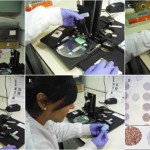Video: Postoperative statin use and risk of biochemical recurrence following radical prostatectomy. Results from the Shared Equal Access Regional Cancer Hospital (SEARCH) database.
Postoperative statin use and risk of biochemical recurrence following radical prostatectomy: results from the Shared Equal Access Regional Cancer Hospital (SEARCH) database
Emma H. Allott, PhD 1, 2, 3, Lauren E. Howard, BA 3, 4, Matthew R. Cooperberg, MD 5, Christopher J. Kane, MD 6, William J. Aronson, MD 7, 8, Martha K. Terris, MD 9, 10, Christopher L. Amling, MD 11 and Stephen J. Freedland, MD 1, 3, 12
1 Division of Urology, Department of Surgery, 4 Department of Biostatistics and Bioinformatics, 12 Department of Pathology, Duke University School of Medicine, 2 Cancer Prevention, Detection and Control Program, Duke Cancer Institute, 3 Division of Urology, Veterans Affairs Medical Center Durham, NC, 5 Department of Urology, UCSF Helen Diller Family Comprehensive Cancer Center, San Francisco, 6 Urology Department, University of California San Diego Health System, San Diego, 7 Urology Section, Department of Surgery, Veterans Affairs Greater Los Angeles Healthcare System, Los Angeles, 8 Department of Urology, UCLA School of Medicine, Los Angeles, CA, 9 Section of Urology, Veterans Affairs Medical Center, Augusta, 10 Department of Urology, Georgia Regents University, Augusta, GA, 11 Department of Urology, Oregon Health Sciences University, Portland, OR, USA
OBJECTIVE
To investigate the effect of statin use after radical prostatectomy (RP) on biochemical recurrence (BCR) in patients with prostate cancer who never received statins before RP.
PATIENTS AND METHODS
We conducted a retrospective analysis of 1146 RP patients within the Shared Equal Access Regional Cancer Hospital (SEARCH) database. Multivariable Cox proportional hazards analyses were used to examine differences in risk of BCR between post-RP statin users vs nonusers. To account for varying start dates and duration of statin use during follow-up, post-RP statin use was treated as a time-dependent variable. In a secondary analysis, models were stratified by race to examine the association of post-RP statin use with BCR among black and non-black men.
RESULTS
After adjusting for clinical and pathological characteristics, post-RP statin use was significantly associated with 36% reduced risk of BCR (hazard ratio [HR] 0.64, 95% confidence interval [CI] 0.47–0.87; P = 0.004). Post-RP statin use remained associated with reduced risk of BCR after adjusting for preoperative serum cholesterol levels. In secondary analysis, after stratification by race, this protective association was significant in non-black (HR 0.49, 95% CI 0.32–0.75; P = 0.001) but not black men (HR 0.82, 95% CI 0.53–1.28; P = 0.384).
CONCLUSION
In this retrospective cohort of men undergoing RP, post-RP statin use was significantly associated with reduced risk of BCR. Whether the association between post-RP statin use and BCR differs by race requires further study. Given these findings, coupled with other studies suggesting that statins may reduce risk of advanced prostate cancer, randomised controlled trials are warranted to formally test the hypothesis that statins slow prostate cancer progression.



